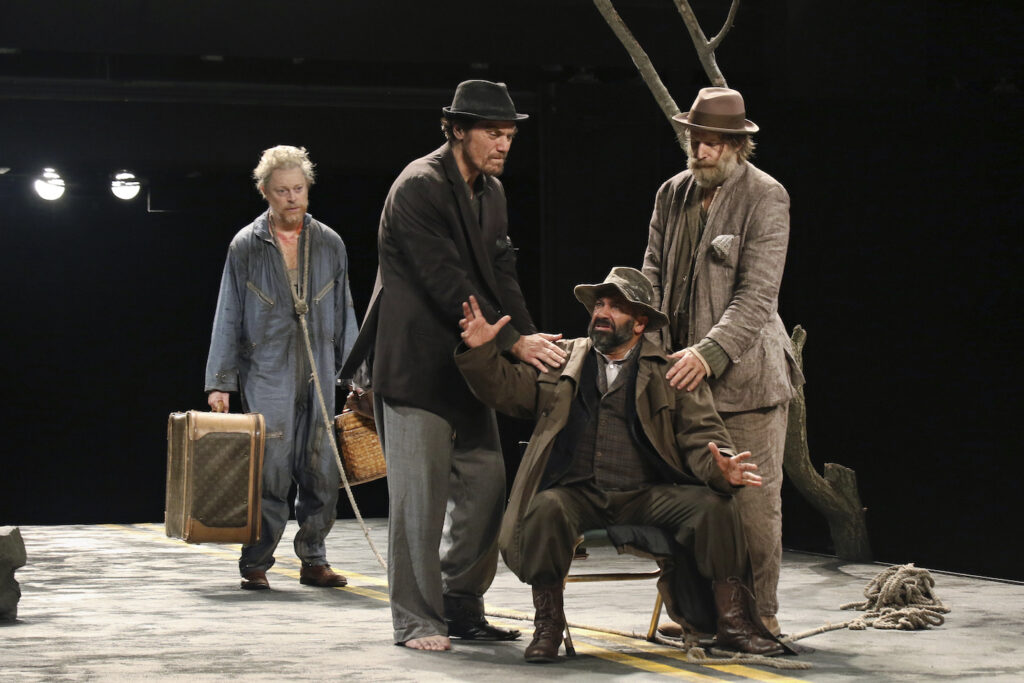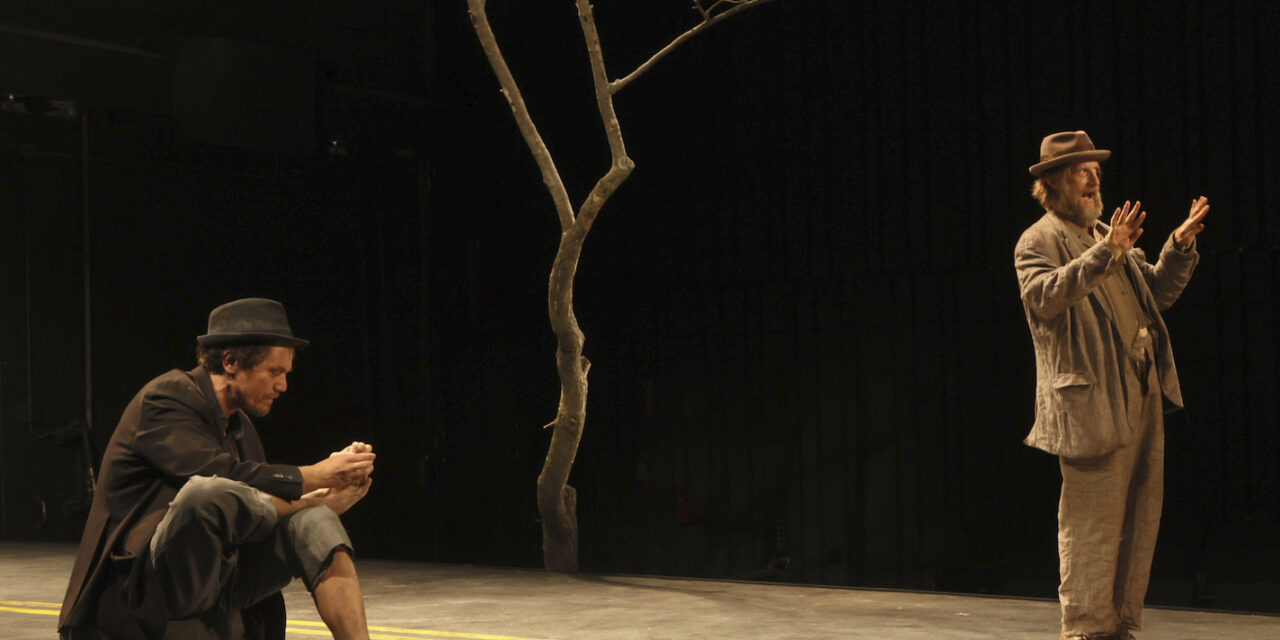Theater Review by Samuel L. Leiter . . . .
Waiting for Godot, Samuel Beckett’s two-act, existential tragicomedy, was first performed, in French, as En attendant Godot, in 1953, and in English in 1953; its first American showing arrived in 1956. Since then it has become perhaps the most highly respected and, probably, the most frequently revived work of the Theater of the Absurd.
It’s so familiar that, when I visited its current incarnation presented by Theatre for New Audience (TFANA) at Brooklyn’s Polonsky Shakespeare Center, I told my plus-one that, since viewing a college production around 1960, I’d probably seen it a dozen times. On reflection, that number is likely to be more like my friend’s own experience of half a dozen or so, which should hold me for the time being.
Over the past 10 years alone, New York has seen at least three noteworthy revivals, one on Broadway in 2013, with Sirs Patrick Stewart as (Vladimir/Didi) and Ian McKellen (as Estragon/Gogo); one Off Broadway in 2019, with little-known actors playing in Yiddish; and another, the only one I missed, briefly seen at the Gerald W. Lynch Theater at John Jay College in Manhattan as part of Lincoln Center’s White Light Festival, featuring Ireland’s Druid Theatre. And that’s not to mention the streaming version presented online by New York’s own New Group in 2021, starring Ethan Hawke as Didi and John Leguizamo as Gogo.

Of the recent live revivals, the first was the best I’d ever seen while the considerably less brilliant second nevertheless had strong values. The third was likewise well received. In the Yiddish production, the language helped emphasize the play’s undertone of human suffering; it also offered the memorable performance of a mime named Richard Saudek in the secondary role of Lucky. I wish I could say otherwise, but the revivals I saw were far more engaging than the lugubrious TFANA revival, directed by Arin Arbus, with stars Michael Shannon as Gogo and Paul Sparks as Didi.
Each revival of Godot seeks a novel way of envisioning a wasteland environment to capture Beckett’s scenic description: “A country road. A tree. Evening.” This locale is where Didi and Gogo, the tramp-like protagonists, await the arrival of a man named Godot (pronounced GOD-ot, like “lotto”), who never comes but sends word that “he will surely come tomorrow.”
Like Groundhog Day, Didi and Gogo go through similar waiting rituals day after day, including considering suicide by hanging from the tree. Only the appearance of two other similarly inscrutable men, Pozzo and Lucky, breaks the grinding monotony before that pair moves on. Both plotless acts conclude with Didi or Gogo saying, “Yes. Let’s go,” after which, fearful of losing the reprieve from their condition that Godot represents, they remain stationary and the act ends.


The Yiddish version substituted for the tree a large, decrepit umbrella lacking its canvas canopy, its naked ribs resembling scrawny branches. In the Stewart-McKellen revival, the set suggested a crumbling old playhouse, in line with the premise that Didi and Gogo had a theatrical past.
For the TFANA production, bleakly lit by Christopher Akerlind, Riccardo Hernandez has split the orchestra level of the space into two facing sides, sandwich style, with a long, paved road, split by a double yellow line, separating one side from the other; a blasted tree rooted at one side bends over the asphalt; a small boulder rests on the other side. I suspect it’s the road to oblivion.
Those seated toward the middle will sometimes find themselves watching the action as if it were a tennis match, constantly shifting their gaze from one side to the other. As is common in such arrangements, they will also watch the audience across the way, especially when prominent celebrities are visible, as happened the night I went.
The principal problem, however, is in the acting. Both Shannon and Sparks are unquestionably compelling presences on both big and small screens, and I’ve often admired their filmic portrayals. However—and I know many of my colleagues disagree—they have a seriousness about them that deflates their attempts at capturing Beckett’s unique blend of hilarity amid miserable circumstances of poverty, hunger, abuse, and despair. Not for a single moment during the dreary, two-and-a-half-hour-plus stretch (with one intermission) did I sense that the actors were doing anything other than acting the comedy rather than inhabiting it. In brief: their humor was forced and they weren’t funny.


Although Beckett provides only the faintest hints of characterization, Stewart and McKellen managed with laser-like insight, pauses, and timing to bring their roles to life, squeezing every line for its minutest nuance, embodying the ragged souls of men with characteristics that made them seem like one-time vaudeville partners for whom comic shtick seemed part of their DNA.
With Shannon and Sparks, though, even the set piece where Didi and Gogo pass their derbies back and forth—brilliantly executed by Stewart and McKellen—is a mundane rendition wanting humorous distinction. (Purists will note that pork pies have replaced derbies.)
Sparks and Shannon, for all the shabbiness of their threadbare costumes (well-conceived by Susan Hilferty) and unkempt facial hair, always appear conscious of their comic chores. Sparks’s Didi is usually the loud, active, decisive half of the duo, Shannon’s Gogo the quieter, passive, beaten one. There are laughs, of course, but very few big ones, the rest being more polite than raucous.
One never senses that this Didi and Gogo not only need the sustenance of food—however inadequate—to survive, but the give and take of repartee to prevent their being crushed by boredom. The bantering of Shannon and Sparks is like watching two quarterbacks competing in a game of tennis. Excellence in one realm doesn’t mean you’ll be good at another—McKellen and Stewart excepted, of course.


Revivals of Waiting for Godot often cast a large, hulking actor to play the cruel taskmaster Pozzo, who cracks a whip and dominates Lucky, the luckless, luggage-bearing slave, attached to a long rope tied around his neck like a leash. Ajay Naidu, who plays Pozzo, is on the shorter side. He brings needed vivacity to the stage with his loudly declaimed lines, but, again, hard as he works, he fails to find an appropriate balance between believability and performability.
Jeff Biehl’s blank-faced Lucky, a dollop of slaver grossly dripping down his white beard in Act 1, gets a hand for his delivery of the character’s single speech, an extremely complex “tirade” composed of non-sequiturs, repetitions, strings of nouns, opaque references, and weird sounds that scholars have attempted to decipher as if it were the Rosetta Stone. He begins very slowly before picking up speed but, aside from his getting through the thing, there’s not much else of interest in his performance. (The same was true of Billy Crudup’s Lucky in the McKellen-Stewart version.) Toussaint Francois Battiste, who normally plays A Boy, was out of the show at my performance; his role was taken by Cricket Brown, who did little to hide her sex.
For all its familiarity, Waiting for Godot remains caviar to the general, with its obscure themes and characters, poetic language mingled with coarseness, and lack of a plot. On the other hand, when someone like me, having seen multiple productions of the play, watches a polished revival led by front-ranking stars and begins for the first time to wonder midway through what it is about this play that earned it its high status, the fault, dear Brutus, must lie somewhere on the stage and not on the page.
Waiting for Godot. Through December 3 at the Polonsky Shakespeare Center/Theatre for a New Audience (262 Ashland Place, Downtown Brooklyn). www.tfana.org
Photos: Gerry Goodstein and Hollis King (as indicated)
Cover Photo: Michael Shannon, Paul Sparks (Photo by Hollis King)


















